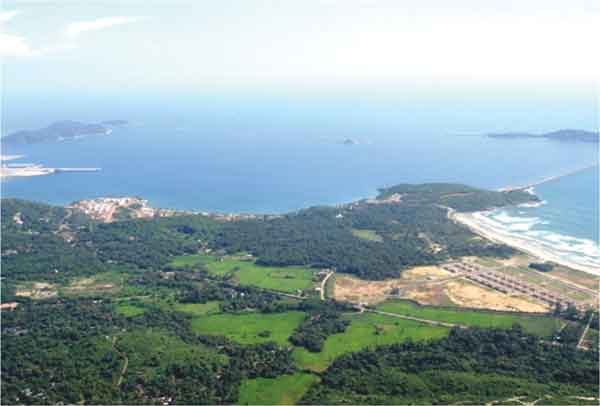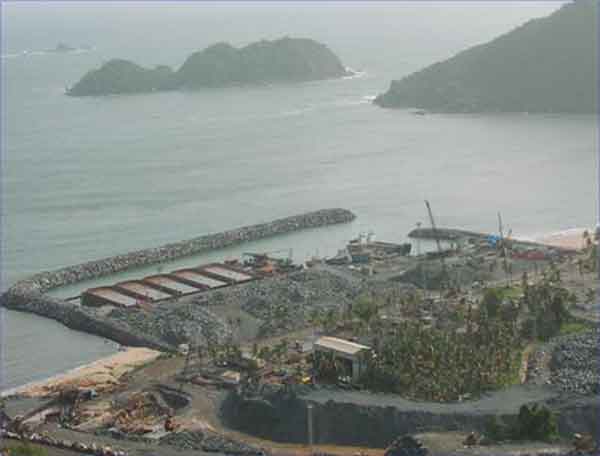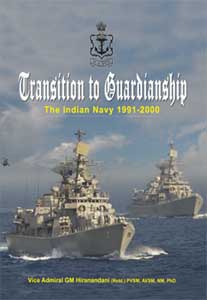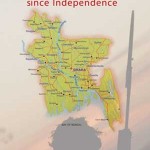During the 1970s, the conceptual requirement for a ‘Third Naval Base’ on the West Coast, in addition to Bombay and Cochin, crystallised. The requirements were:
- Large waterfront with sufficient depth of water for anchorage.
- Sufficient contiguous backup area inland for operational, technical, administrative and logistic facilities.
- Exclusiveness for integrated development and security considerations.
- Rail, road and sea communications.
Click to buy: Transition to Guardianship: The Indian Navy 1991-2000
The Choice of Karwar
The locations considered were Ratnagiri, Pawas Bay, Goa, Karwar, Tadri, Mangalore and Tuticorin. The short-listed options emerged as Mangalore, Tuticorin, and Karwar. Karwar emerged as the preferred location.
Karwar was located 80 kms south of Goa and 320 kms north of Mangalore. Its location gave it the benefit of being free from cyclonic devastation. Many small islands, including Anjadip, offered protection against natural elements from the north, west and southwest. It had deep waters. The four-fathom line (24 feet) ran extremely close to the shore all along the coast. The range of tide was 2.5 metres (7 feet) during spring tides and 1.2 metres (4.5 feet) during neap tides.
Two perennial rivers, the Kalinadi River to the north of Karwar Head and the Gangavalli River to the south, would provide potable water, uninterrupted water supply and had hydel potential. The Kalinadi Hydel Power Project was expected to generate a total of 1316 MW of power in its three phases.
The Karnataka State Government was developing Karwar commercial port in three stages to create an all weather port to handle ships up to 60,000 ton DWT for ore and other general cargo traffic.
National Highway 17 was being widened and strengthened to take 20-ton cargo trucks. The West Coast north-south Konkan Railway was to pass through Karwar. The Third Naval Base was included in the 1980–85 Defence Plan.
Acquisition of Land
The initial projection was to acquire 20,400 acres of land, with an additional 5,000 acres for future development. The bulk was forest land followed by private and revenue land. The Karnataka Government agreed to give the forest and revenue land free of cost but stipulated that private land owners should be fully compensated, including bearing the cost of constructing rehabilitation centres with all essential amenities for villagers dwelling in the areas.
 By 1983, the total land requirement was brought down by a re-survey, eliminating inaccuracies in mapping and omitting the forest areas that had earlier been included for security considerations. During the initial period, land acquisition was restricted to 12,354 acres, of which 8,220 acres were to be acquired immediately and the balance later.
By 1983, the total land requirement was brought down by a re-survey, eliminating inaccuracies in mapping and omitting the forest areas that had earlier been included for security considerations. During the initial period, land acquisition was restricted to 12,354 acres, of which 8,220 acres were to be acquired immediately and the balance later.
Of these 8,220 acres, 5,765 acres were forest land, 2,445 acres were private land and the balance revenue land. The 13 villages located in the private land had to be rehabilitated before the land was acquired.
Laying of Foundation Stone
In 1985, sanction was accorded for Phase I of the project. Due to the enormity of the project and the fact that no Indian firm had undertaken planning and construction of such a major naval base, the Government approved inviting global tenders for consultancy. It was decided also to select a suitable Indian firm to be associated with this work.
For the management of the project, the Government approved the constitution of an Apex Body headed by the RRM, a Project Management Board headed by the Defence Secretary and a Project Management Authority headed by a Director General, (DG) who would be a Rear Admiral.
On 24 October 1986, Prime Minister Rajiv Gandhi, laid the foundation stone for the Third Naval Base and christened it as ‘Project Seabird’.
From 1986 onwards, DG Seabird started liaising with the Ministry of Railways for connecting Karwar to their rail network and with the Ministry of Surface Transport to divert National Highway 17 for meeting security requirements.
Selection of Consultants
The first step was to select a suitable Indian consultant to prepare the broad requirements for inviting global tenders and draw up the Detailed Project Definition.
A Committee of Secretaries was constituted to select an Indian firm as consultant. From amongst the various firms that were pre-qualified, the Committee recommended Engineers India Ltd as the prime consultant for the Project. This was approved by the Government.
Along with Engineers India Ltd, a global tender was floated for inviting consultants for planning and designing Phase I of the base. A total of forty-two firms and consortiums responded from all over the world, of which five were short-listed. In consultation with Engineers India Ltd, M/s Regional Engineering Development Consultants of Australia (Redecon) and M/s Netherlands Engineering Consultants of Netherlands (Nedeco) were selected as the foreign consultants.
The main tasks of the foreign consultants were to prepare a Master Plan along with a Detailed Project Report (DPR) for the marine works. The Indian consultants were to prepare a Detailed Project Report for the on-shore works.
Studies, Investigations and Model Tests
Prior to finalising the Master Plan and the Detailed Project Report, all the necessary geo-technical investigations, marine environment investigations, model testing of breakwaters, etc were carried out. The Central Water and Power Research Station Pune conducted the wave and motion studies of the harbour and its configuration; these helped to evolve the design and configuration of the breakwaters to obtain optimal tranquility conditions inside the harbour. The studies for model testing included investigations of prevailing wave, tide and wind conditions, sediment flow, soil testing, etc.
 The Master Plan was prepared by March 1990. The Detailed Project Report for the construction of breakwaters, dredging and reclamation was completed in June 1990. Engineers India Ltd submitted the Detailed Project Report for the on-shore facilities in August 1990.
The Master Plan was prepared by March 1990. The Detailed Project Report for the construction of breakwaters, dredging and reclamation was completed in June 1990. Engineers India Ltd submitted the Detailed Project Report for the on-shore facilities in August 1990.
Revised Phase I
Due to the 1991 financial crisis and the shortage of resources the project could not progress further between 1990 and 1994. This pause was utilised to prune down Phase I of the project. In 1995, Government approved the Revised Phase I.
Selection of the Construction Consortium
Since the expertise for constructing breakwaters was not available within the country, global tenders were invited for constructing the marine works, which comprised both dredging and construction of breakwaters. The remaining facilities were to be constructed by a suitable Indian agency, with the exception of the ship lift. The latter was to be undertaken by a foreign firm, as the technology for its construction was not available within the country.
Approval was accorded for the engagement of M/s Redecon and Nedeco as the consultants/engineers for supervising the construction of marine works.
A total of 37 potential builders responded to the global tender. After pre-qualification, seven foreign and seven Indian firms were short listed for breakwater construction and quarrying. One Indian and three foreign firms were short listed for dredging and reclamation work. The Indian firms were pre-qualified only for quarrying activities and the foreign firms for construction of breakwaters. In order to have a single point of contact, the foreign firms were advised to form a consortium with the Indian firms and bid for the marine works.
Redecon and Nedeco prepared tender documents for the execution of the marine works. The consortium of Hochtief of Germany, Ballast Nadam of Netherlands and the Larsen & Toubro of India was selected on the basis of lowest tender.
| Editor’s Pick |
The Project Management Board approved this tender in April 1998, subject to the condition that the “core area” comprising the three villages of Chendia, Arga and Binaga had been vacated prior to acceptance of tender. The tenders could not be accepted immediately because the Karnataka Government had not been able to vacate the core area.
Rehabilitation of Project-Affected Families
The rehabilitation of the Project-affected families turned out to be a major task. The Karnataka Government had given the forest and revenue lands free of cost. The Central Government had to provide the funds for the rehabilitation of the villagers, provide compensation for private land and for the creation of suitable “rehabilitation centres”. The vacation of land was to be done by the Karwar District authorities. The initial estimate was vacation of 13 villages with about 2900 families. While sanctioning the project in 1985, a sum of Rs 9 crores had been earmarked for this purpose. Due to the delay in execution of the project, only part of the money was paid as compensation to some project-affected families.
In early 1997, when the Karnataka Government was requested to vacate all the project-affected families from the villages, there was serious resistance regarding inadequacy of the rehabilitation package. The Karnataka Government discussed the rehabilitation package de-novo with the project-affected families and in June 1997, suggested an additional requirement of Rs 16 crores. This revised amount was not acceptable to the project-affected families and their agitation continued.
In June 1998, the Karnataka Government was again requested to arrange vacation of the villages in a time bound manner. At this juncture, the Karnataka Government projected an additional requirement of Rs 90 crores. After high-level meetings, the rehabilitation package was revised to Rs. 90 crores in August 1998. This included Rs 2 crores towards a stipend of Rs 1000/- per month per eligible student for pursuing Industrial Technical Institute (ITI) vocational training for a period of two years. It was hoped that ITI training would make these young men employable in the new Dockyard’s workshops.
The vacation of the villages and the rehabilitation of villagers commenced in March 1999. At this stage, the project-affected families moved the High Court of Karnataka and also petitioned the National Human Rights Commission. These institutions carried out field investigations and directed certain additional facilities and provisions to be made at the rehabilitation centres. In the interim period, the total number of project-affected families had risen to over 5500. This included about 1000 families who were found dwelling in the villages at the time of rehabilitation. The final rehabilitation package of Rs 127 crores was agreed upon in April 2000. The 13 villages were resettled in seven rehabilitation centres. Of these, three rehabilitation centres were located along the coast for the benefit of fishermen and the remaining four were located inland for agriculturists and other categories. The villages started being vacated in 1999.
Commencement of Works
On commencement of the vacation of the core area, tenders for marine works were accepted; contracts were signed in October 1999. Temporary works started of quarrying and construction of roads. All three villages were finally vacated by September 2000 and works commenced in October 2000 with the commencement of dredging for the breakwaters. 49 hectares of land were reclaimed and 5.14 kms of breakwaters were constructed.
Completion of Phase I
The commissioning of Karwar’s naval base, INS Kadamba, on 31 May 2005 marked a milestone achievement in the completion of Phase I. The shiplift’s commissioning and construction of civilian dwelling units got delayed due to reasons beyond control. These would be ready by 2006 and 2008 respectively. The first naval ship entered harbour on 14 November 2004 and berthed alongside the 420 metre jetty on Navy Day, 04 December 2005.
The base has a sea front of 26 kms and a total area of 11,200 acres. With its capability for lifting vessels of 10,000 tons displacement, the Ship Lift and Transfer System can lift all the ships and submarines of the Navy except for aircraft carriers and tankers.
Relocation of Men, Material and Ships from Bombay to Karwar
 Since it would take time to establish special to type maintenance and repair facilities, the present intention is to base only non-fleet ships like OPVs, minesweepers and survey ships at Karwar. The workshops would be ‘generic’ rather than ‘specific for classes of ship’. As facilities develop, Karwar would start being used by other classes of ships.
Since it would take time to establish special to type maintenance and repair facilities, the present intention is to base only non-fleet ships like OPVs, minesweepers and survey ships at Karwar. The workshops would be ‘generic’ rather than ‘specific for classes of ship’. As facilities develop, Karwar would start being used by other classes of ships.





I am lecturer in mechanical engg dept of Bapuji polytechnic ,Davangere, karnataka.. already sent letter for permission to visit Naval base karwar for our final year students to Flag officer, commanding , INS Kadamba, naval base karwar on 20/08/2015 by fax & hard copy by speed post . so please kindly early reply . we are awaiting for your reply .
I AM WORKING WITH HAL-PIMPRI(GOVT OF INDIA) LIVING IN PUNE .DURING SUMMER VACATION MY FAMILY -WIFE AND DAUGHTER WISH TO VISIT / SEE YOUR NAVAL BASE .SO I REQUEST YOU TO GIVE US THE PERMISSION.
THANKS
What is the final list of villages being impacted/evacuated as a result of the current / projected plan?
Will the city of Karwar and places like Sadashivgad, Devbagh be evacuated?